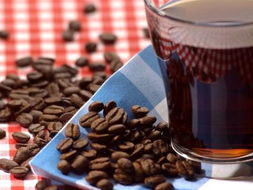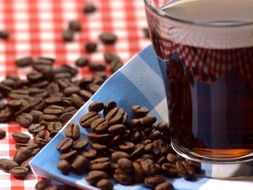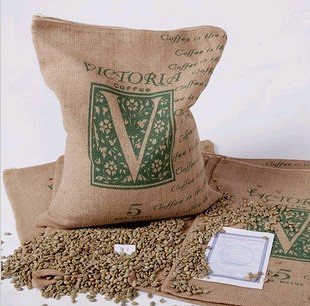How much is the coffee bean? the price of a jin of coffee and raw beans is Yega Ficher kochere.
Coffee seeds cannot be grown directly with coffee fruits picked from coffee trees. Peeling coffee fruits is just like planting peanuts. If you plant a peanut with a shell in the soil, it cannot sprout. You must plant peanuts. It is the same with medium coffee. If you have coffee fruit in your hand, you can bask it in the sun first and shake it until it is shaken. (like sun-dried peanuts), you can peel off the shell of the coffee fruit and plant it with coffee seeds inside. Coffee trees must be planted near the equator in the tropics and subtropics at latitudes 23 °N and 25 °S. In China, only Taiwan, Hainan and Yunnan can grow coffee trees.
The cultivation of coffee beans
Indoor growth is best placed in a place with plenty of light. Non-direct sunlight or fluorescent lighting such as an office or kitchen has good light conditions.
(watering)
Place the tree in a sink or container and water until water leaks from the drain at the bottom of the basin. Repeat this step until all the roots are wet. It is usually OK to water it once a week. Don't keep the soil wet all the time. Don't water too much! To avoid getting too wet, keep the water tray under the flowerpot dry.
(fertilization)
You can buy liquid fertilizer from the horticultural shop and fertilize it according to the method of indoor plants.
(temperature)
Coffee is a subtropical plant, growing at about 61F ~ 74F (16C ~ 23C). It can withstand temperatures of about 55F (12C) to 80F (27C) and still bloom. Don't let it get cold! If you put it in the sun or in a hot place, water more so as not to wither the plants.
Coffee grows well indoors and can be an ideal home or office plant. Switching to a large flowerpot will make the tree open higher, and if the conditions are right, it will blossom and bear fruit. Use basin soil with good drainage, such as camellia mixed soil in local horticultural shops.
Country: Ethiopia
Grade: G2
Producing area: Yejia Xuefei
Baking degree: shallow baking
Treatment: washing
Variety: native species
Flavor: Jasmine, lemon, bergamot, honey, black tea
Cochel is located in a small producing area 25 kilometers southeast of Yegashafi, Ethiopia. It is a rich area for coffee production. It is also one of the three famous and micro-producing areas of Yegashafi. It has about 100,000 local residents, and coffee beans are the main source of income. The processing and processing equipment in this area is very advanced. CoffeeReview, a well-known coffee evaluation website, gave Kocher a high rating of 94 points for washed beans.
There are eight main coffee producing areas in Ethiopia: Nekempte (Lekempti) Gimbi Kinby, Limulim, Illubabor Ibedo, Djimma Gemma, Harrar Hara, Teppi/Bebeka Bebeca, Sidamo Sidamo, and Yirgacheffe Yega Chefe. Among them, the more well-known boutique coffee producing areas are Nekempte (Lekempti), Limu, Harrar, Sidamo and Yirgacheffe,Yirgacheffe, which are located in the Sidama region of Ethiopia. It can be seen that Yirgacheffe belongs to the smaller region of the Sidama producing area.
Yejaschuffe itself is a small town of about 20, 000 people, and the three neighboring producing areas, Wenago, Kochere and GelenaAbaya, are also classified as Yejasuffe because they produce coffee with almost the same flavor as Yejasuffe. Yejacheffe is similar to the neighboring Sidamo in terms of culture and geography, but it seems to be more favored to enjoy the advantageous conditions, top-quality Yega Chefe coffee with floral aromas, bright citrus acidity, lemon flavours and silky taste.
Kochere Cochel is located in southwestern Ethiopia, 25 miles north of the famous town of Yega Chefen. The production model is based on local small farmers sending production batches to cooperatives for unified processing. The local Chalalacktu village has about 100000 people who depend on coffee for a living, and related production activities have become their main source of income. Due to the benefits brought by coffee production, the local standard of living is much better than that of many Ethiopian villages, with sound health facilities, colleges and universities, and so on. The advanced processing equipment makes the coffee in Kochere area always have a high level of performance in the field of washing treatment, with the clean and sweet complex flavors of molasses and citrus.

Important Notice :
前街咖啡 FrontStreet Coffee has moved to new addredd:
FrontStreet Coffee Address: 315,Donghua East Road,GuangZhou
Tel:020 38364473
- Prev

How much is a kilo of coffee beans? how to buy coffee beans? Ethiopian native species sun-dried coffee raw bean price
Coffee seeds cannot be grown directly with coffee fruits picked from coffee trees. Peeling coffee fruits is like planting peanuts. If you plant a peanut with a shell in the soil, it cannot sprout. You must plant peanuts. It is the same with medium coffee. If you have coffee fruit in your hand, you can first bask it in the sun and shake it until it is shaken inside.
- Next

How much is a kilo of coffee beans? coffee beans grow seeds in Africa, Tanzania, Kilimanjarozhen.
Coffee seeds cannot be grown directly with coffee fruits picked from coffee trees. Peeling coffee fruits is like planting peanuts. If you plant a peanut with a shell in the soil, it cannot sprout. You must plant peanuts. It is the same with medium coffee. If you have coffee fruit in your hand, you can first bask it in the sun and shake it until it is shaken inside.
Related
- Detailed explanation of Jadeite planting Land in Panamanian Jadeite Manor introduction to the grading system of Jadeite competitive bidding, Red bid, Green bid and Rose Summer
- Story of Coffee planting in Brenka region of Costa Rica Stonehenge Manor anaerobic heavy honey treatment of flavor mouth
- What's on the barrel of Blue Mountain Coffee beans?
- Can American coffee also pull flowers? How to use hot American style to pull out a good-looking pattern?
- Can you make a cold extract with coffee beans? What is the right proportion for cold-extracted coffee formula?
- Indonesian PWN Gold Mandrine Coffee Origin Features Flavor How to Chong? Mandolin coffee is American.
- A brief introduction to the flavor characteristics of Brazilian yellow bourbon coffee beans
- What is the effect of different water quality on the flavor of cold-extracted coffee? What kind of water is best for brewing coffee?
- Why do you think of Rose Summer whenever you mention Panamanian coffee?
- Introduction to the characteristics of authentic blue mountain coffee bean producing areas? What is the CIB Coffee Authority in Jamaica?

